20 passive homes ideas that could help cut the running costs of your build
These show-stopping passive homes are not only beautifully designed but also perform to a high-efficiency standard to help save money on running costs
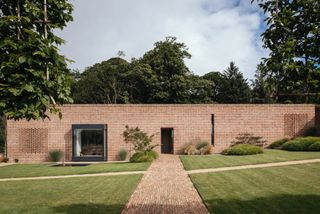
While the Passivhaus standard has pushed cutting-edge technologies to the fore, achieving certification can be difficult and expensive. But it doesn't mean you shouldn't add these energy-efficient concepts into your renovation and self build project — in fact quite the opposite is true.
"Passive homes" are those that fulfill all the Passivhaus requirements but are not actually Passivhaus accredited. Passive homes can include renewable technologies, such as mechanical ventilation with heat recovery (MVHR), high spec building materials for airtightness and increased levels of energy-saving insulation.
Get inspired by passive design projects below — that prove energy efficient buildings can be both beautiful and full of innovation.
1. Building a Passivhaus mews home to save money
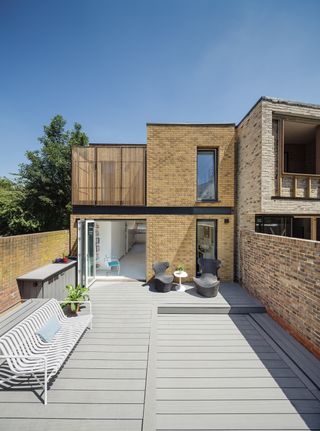
The Passivhaus standard originated in Germany in the 1990s. A group of academics formalised the passive design techniques that have been used for centuries, such as insulating to high levels and positioning homes for solar gain.
In short, Passivhaus homes need less than 30% of the energy for space heating than an equivalent house build to the current Building Regulations standards.
Clever design allowed downsizer Elizabeth Sharp to build a Passivhaus mews house in South London at the fraction of the cost of buying in the area.
RDA Architects designed and built the house with Elizabeth using Structural Insulated Panels (SIPs) and triple (and in some places quadruple) glazing.
With annual bulls of around £300, the super-insulated and airtight structure also features a small swimming pool with a load-bearing decking cover.
2. Including solar-heated underfloor heating
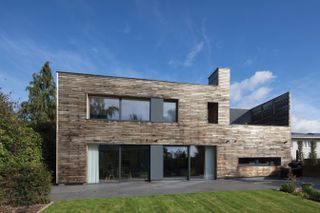
Since its launch in 1990 with four houses in Darmstadt, there are now more than 1,000 certified Passivhaus buildings in the UK (as of 2018) and over 60,000 worldwide.
After making the hard decision to knock down her much-loved childhood home (a chalet bungalow in Hertfordshire), Sarah MacLaren and Daniel Luhde-Thompson opted to self-build to Passivhaus standards.
They worked with Tom Gresford of Gresford Architects to develop the plans through the detailed design and construction phases (Nicholas Tye Architects submitted the original plans to achieve outline planning permission).
Key features of the timber frame house include:
- Warm 2,700K LED lighting throughout the house
- Solar-heated underfloor heating
- Rainwater harvesting that supplied the home's grey water
- Recycled paper insulation
- An MVHR system
3. Using high-spec SIPs to ditch need for a heat pump
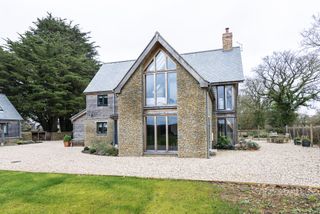
Tony and Emma Cooke worked with Roderick James Architects to design their highly-efficient oak frame self-build.
The couple chose new, thicker high spec SIPs which meant they didn't need to install a heat pump to warm the house, instead they solely reply on two woodburners.
While they didn't end up applying for certification in the end as it was too pricey, the house most certainly delivers both style and performance.
4. Plugging gaps with airtight tapes and membranes
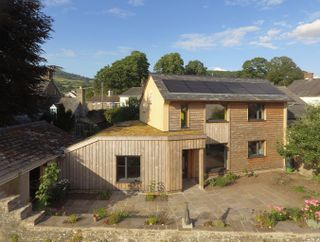
Designed by Architect Adrian Cooke. this Passivhaus-certified self-build in Powys demonstrates the need to take a holistic approach when optimising a property's thermal efficiency.
Triple-glazed windows, thermally efficiency door units with dual compression seals and an MVHR system were provided by Green Building Store, as were countless essentials such as airtightness tapes and membranes.
The house's minimalist combination of roughcast render and timber cladding reflects the need to respect the local vernacular, showing that a green build needn't compromise on aesthetics.
5. A butterfly roof to move away from 'boxy' design
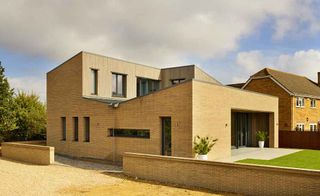
Designed by package company Potton, this Passivhaus show home was designed using the Passivhaus Planning Package (PHPP) in association with HTA Design. Derived from a desire to flood the interior with natural daylight, a series of simple design moves creatively breaks down ‘the Passivhaus box’, employing large openings and a distinctive butterfly roof.
Central to the design is a top-lit enclosed ‘courtyard’ which sits at the heart of the building, filling the centre of the floorplan with natural daylight. A large south-facing opening on the ground floor has been maximised to benefit from solar gain, which, combined with other Passivhaus principles, helps to reduce the energy consumption of the house to 15kWh/m2/yr for heating. The roof overhang then protects this glazing from excessive solar gain and overheating of the interior during the summer, while maximising solar gain during the winter months.
The airtight building has been constructed using SIPs, is heavily insulated, and includes triple glazing and MVHR. Hot water is provided using a micro air source heat pump that is ducted to outside the property.
6. A simple barn Passivhaus with a prefab frame
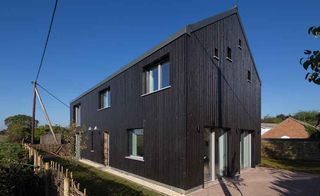
This Passivhaus in Berkshire was built by Gresford Architects using a prefabricated timber frame, constructed off site and then erected on site to airtight stage within two weeks. Clad in vertical timber panels, the exterior façade nods to the traditional agricultural buildings in the area.
7. Building around a protected lime tree in Norfolk
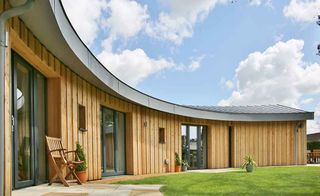
Sitting within a garden plot in Norfolk, Lime Tree Lodge challenges the conventional straight-lined form of typical Passivhaus projects, as it curves its way around a protected lime tree on the site. Built by Parsons + Whittley Architects as a retirement bungalow for homeowners Rob and Jane Young, the curved design positions the tree as the central focus for both the building and the garden.
Recognising that the tree could provide shade in the summer but allow sunlight through in winter, the opportunity for a large south-facing glazed wall for the sitting room, together with the client’s request for a low-energy building for their retirement, all led to the early adoption of the Passivhaus standard.
Built using masonry construction – selected as a result of labour availability and thermal mass – the property features brick cladding to the street-facing elevation which complements the adjacent inter-war and 1980s buildings. Siberian larch provides a softer aesthetic on the rear façade. Large overhangs on this south-facing elevation also provide protection against overheating.
8. Using flat elevations to boost energy efficiency
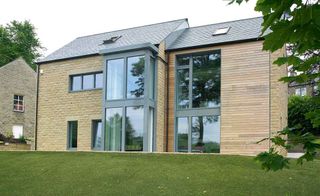
After a four-year planning battle, Angela and Paul Dallas managed to self build their low-energy Passivhaus with the help of Green Building Store. Externally, the project has been finished in stone, which suited the cavity wall construction method — the use of a cavity wall also sat well within the comfort zone of the builders in the area. Cedar cladding adds interest and helps to break up the façade.
The full-height glazed bay window was problematic while building to Passivhaus standards (as homes perform better with flat elevations) but the bay was built with triple-glazed timber windows and insulated with polyurethane.
9. A German kit passive home in somerset
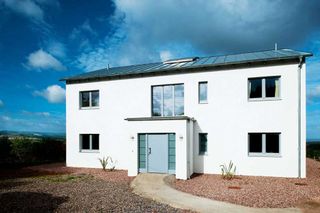
This home was built in just four months as a turnkey project by German manufacturers Hanse Haus. The owners originally had plans to extend and update their draughty 1930s home, but realised it would be as cost-effective to build a new, highly efficient home instead. Building to Passivhaus standards has also given them incredibly low fuel bills and a constant internal temperature.
Despite the planning constraints of building in an Area of Outstanding Natural Beauty, they have managed to create a stylishly modern home. White rendered walls have been paired with a zinc roof, and large areas of glazing with external blinds for shading.
10. Achieving airtightness with specialist cat flap
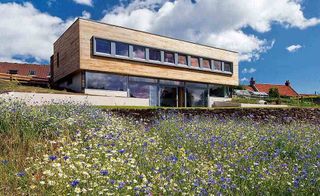
This contemporary Passivhaus was built on a sloping site in the Scottish borders. The home features a stone-clad frontage with a cedar-clad, glazed elevation to the rear. A roofstrip of glazing along the length of the building floods the interior with natural light and forms a glass division between the north and south elevations.
Due to high levels of insulation and airtightness, the only used source of heat in the house is a woodburning stove. Underfloor heating has been installed in the two bathrooms but has never been used — even when temperatures dropped to -16°C one winter. The owners have even included a special cat flap and letterbox to maintain airtightness.
11. Sheep wool insulation from self builder's own flock!
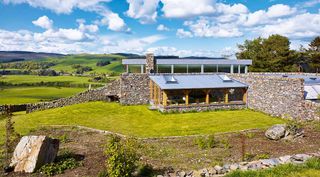
This carbon negative home was built mostly from materials sourced from the 300-acre farm it sits on. Cladding was made from wind-felled oak tress and the dry stone wall from 500-tonnes of rock collected from the land. Turf from the site covers the Sarnafil flat roof, helping it camouflage with the landscape.
Layout has been influenced by passive solar gain, with the stunning views enjoyed through triple glazed windows. The 150mm thick sheep’s wool insulation has been shorn from the owners’ flock. A biomass stove, situated in the heart of the home, heats the interior stone wall, evenly distributing warmth.
12. A passive home made with a steel frame
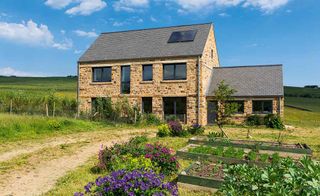
Positioned on an isolated site in the North Pennine Area of Outstanding Natural Beauty (AONB), Steel Farm Passivhaus has been built using traditional masonry construction with the design taking the form of a modern-day farmstead, clad in stone under a slate roof.
Built on a site without mains gas, the home – designed by Mark Siddall of LEAP: Lovingly Engineered Architectural Practice – is heated with small gas cylinders topped up with solar thermal panels for domestic hot water. AECB’s (Association for Environment Conscious Building) water standards informed the design and have minimised the demand for domestic hot water without compromising comfort. There’s also a reed bed system for the treatment of foul waste water.
Triple-glazed timber windows and doors from Green Building Store and a mechanical ventilation heat recovery (MVHR) system complete the project.
Each year Steel Farm has taken part in the International Passivhaus Open Day event, members of the public get to experience what a Passivhaus is really like. You can watch the popular documentary about the house, and get the opportunity to visit the Steel Farm, at passivhaussecrets.co.uk
13. Siberian larch and a sedum roof for an organic look
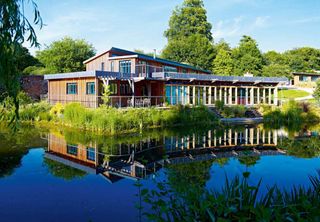
Both passive and active eco features have been incorporated into the design of this Oakwrights home in Gloucestershire. The house has been set into the slope, with a large basement level that keeps the external volume of the home to a minimum, reducing heat loss.
The home has then been orientated so that significant areas of glass face south. Eco features are complemented by the use of untreated Siberian larch and a sedum roof for an organic look.
14. Using well-positioned glazing to warm things up
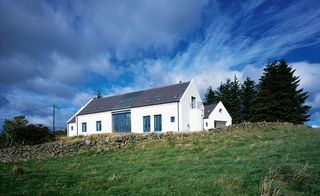
Built to replace an old cottage, this modern take on a rural longhouse is just one room deep. Glazing is limited on the northern elevation, with south-facing glazing bringing light (and warmth) into the home.
The house has been built using an innovative blockwork system – with 100mm of internal insulation blockwork – achieving a U value of just 0.12. The walls have been coated in a crisp white render, but the overall look takes cues from the local vernacular.
15. Using historic materials to achieve 0.13 U value
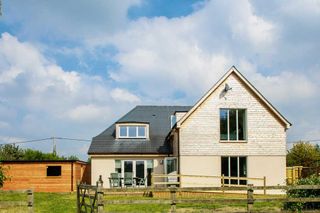
Historic building materials have been paired with modern construction methods in this traditional style home with high energy efficiency. The owner is well known in building conservation circles, so it came as some surprise when he swapped their 17th century brick and flint home for a new build. However, the new home has an average heat demand of just 2.5kW, costing only £1.25 a day to run.
The combination of 300mm hemp/lime and hemp-fibre walls gives a U value of just 0.13. The walls are also vapour-permeable to regulate humidity and create a comfortable environment, which can be hard to achieve in such well-insulated, airtight homes.
16. A contemporary Passivhaus self-build with a central glass-roofed courtyard

Inspired by the old brick garden wall beside it, Eileen and Nigel Dutt’s unique Devon Passivhaus initially faced strong opposition from the planners. The contemporary building, designed by architects McLean Quinlan, is principally a single-storey, flat-roofed house, with a central glass-roofed courtyard and a partial basement.
The house was built using structural insulated panels, manufactured off site, offering minimal thermal bridging, core strength, and low U-values. “Our builder drew our attention to the 4wall structural panelling system, made just a few miles away,” says Nigel. “We were on site every day and were able to watch the panels being erected over just eight weeks.”
Brickwork was then built using lime mortar, with an English bond and pierced sections which break up the long wall and cast shadows as sunlight passes through. Behind this, the building has been finished in a dark grey render, chosen to recede into the setting.

Debbie Jeffery is an award-winning journalist and property expert whose career spans more than 25 years. She has developed a broad technical knowledge – specialising in producing in-depth features on all aspects of homes and gardens for national newspapers, architectural journals and home interest titles, which have been syndicated around the world.
17. Budget passive home renovation of a 1960s semi
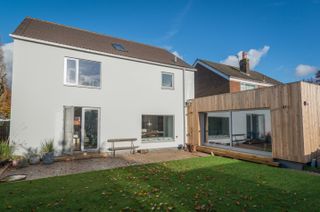
Russel and Anna Hayden have taken a derelict 1960s suburban house and given it a comprehensive eco-makeover. “The house hadn’t been touched since it was built,” explains Russel, an architect and certified Passivhaus designer at Hesketh Hayden. “Our plan was to make it as sustainable as possible, aiming for Passivhaus certification, or at least the refurbishment equivalent, EnerPHit.”
Radical modifications were made to the uninsulated brick and block cavity wall construction, including installing triple-glazed windows, external doors and rooflights, with high levels of insulation to the walls, roof, and floors.
“Working with an existing house is harder than a new build, especially as we had quite a tight budget of £170,000,” explains Russel. “We used Passive House Planning Package software, which is an energy-efficiency tool that takes information about the house and accurately predicts how it will perform. Living inside a Passivhaus is rather like being inside your own healthy little bubble.”
18. Go off grid with a low energy curved cabin
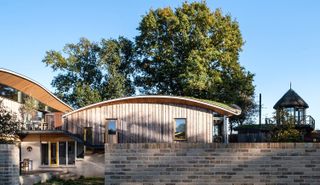
Situated in an AONB in the Suffolk Broads, this innovative creek-side cabin is a marvellous example of an eco house, constructed to Passivhaus principles with off-grid energy systems and a flood-resilient design.
A collaboration between MAP Architecture and Jon Broome Architects, the cabin replaces a smaller holiday home and was mainly built from natural materials and elements with low environmental impact.
External walls at first floor level are of Steico insulated joists, with sheeps wool and wood fibre insulation. Sustainable Kebony softwood cladding was chosen, which develops a natural silver-grey patina, and with triple-glazed windows a final airtightness was achieved of less than 1.
Unique curved planted roofs, made from straight sections of engineered joists, were designed to look like rolling meadows to blend with the surrounding fields and appear to float above the cabin. The depth of the overhang increases as the roof height rises to provide shading during summer.
19. Squeezing a Passivhaus into a London basement
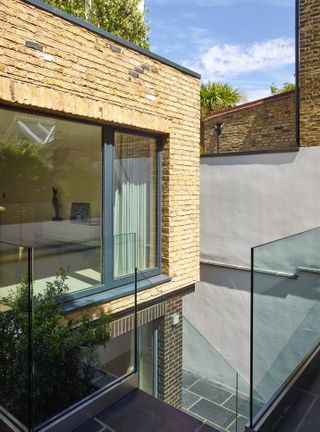
Overcoming a fraught three-year planning process, this certified Passivhaus - designed by RDA sits on the site of a former garage, on a tight corner plot, in a street of Edwardian Chiswick homes.
Three bedrooms, generous living areas, and outdoor spaces were achieved through the addition of a basement: sinking the waterproof concrete lower storey below street level, so that half of the building’s volume is hidden from view and opens onto a secluded courtyard garden.
White render and London stock brick slips visually break up the two upper storeys, while internally the exposed concrete walls and bespoke timber staircase are strikingly contemporary.
High levels of insulation, Optwin Passivhaus-certified windows and doors and triple-glazed rooflights mean that no heating is required, and a mechanical ventilation and heat recovery unit (MVHR) in the lower ground floor utility room uses outgoing stale air to warm incoming fresh air.
20. Add a courtyard to your Passivhaus design
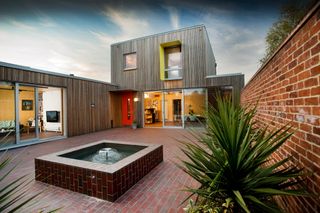
Four days is all it took to build the shell of Ruth Butler and Julian Sutherland’s contemporary courtyard Passivhaus, using cross laminated timber panels, with the entire project taking just seven months to complete. “As an architect married to an engineer it was always something we planned to do,” explains Ruth Butler.
By arranging the 150m2 L-shaped building around the edges of the small brownfield site, and enclosing a walled courtyard, complete privacy could also be assured for the family.
The cross-laminated timber panel system is not only fast to build but is also inherently airtight, and the whole family flew out to visit the Austrian factory. “As we were building through the winter it was a relief to see the shell of the house go up in just four days, creating a dry space for the rest of the trades to continue working,” says Ruth.
The eco benefits of these homes are undeniable and they come with many other benefits too, but there are a few things to know about living in a Passivhaus that are worth getting up to speed with before taking the leap with your own project.
Get the Homebuilding & Renovating Newsletter
Bring your dream home to life with expert advice, how to guides and design inspiration. Sign up for our newsletter and get two free tickets to a Homebuilding & Renovating Show near you.
- Debbie JefferyHomes Journalist